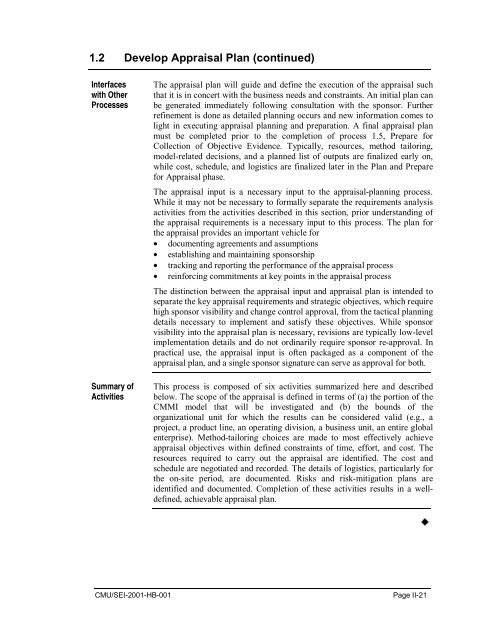Standard CMMI Appraisal Method for Process Improvement (SCAMPI)
Standard CMMI Appraisal Method for Process Improvement (SCAMPI)
Standard CMMI Appraisal Method for Process Improvement (SCAMPI)
Create successful ePaper yourself
Turn your PDF publications into a flip-book with our unique Google optimized e-Paper software.
1.2 Develop <strong>Appraisal</strong> Plan (continued)<br />
Interfaces<br />
with Other<br />
<strong>Process</strong>es<br />
Summary of<br />
Activities<br />
The appraisal plan will guide and define the execution of the appraisal such<br />
that it is in concert with the business needs and constraints. An initial plan can<br />
be generated immediately following consultation with the sponsor. Further<br />
refinement is done as detailed planning occurs and new in<strong>for</strong>mation comes to<br />
light in executing appraisal planning and preparation. A final appraisal plan<br />
must be completed prior to the completion of process 1.5, Prepare <strong>for</strong><br />
Collection of Objective Evidence. Typically, resources, method tailoring,<br />
model-related decisions, and a planned list of outputs are finalized early on,<br />
while cost, schedule, and logistics are finalized later in the Plan and Prepare<br />
<strong>for</strong> <strong>Appraisal</strong> phase.<br />
The appraisal input is a necessary input to the appraisal-planning process.<br />
While it may not be necessary to <strong>for</strong>mally separate the requirements analysis<br />
activities from the activities described in this section, prior understanding of<br />
the appraisal requirements is a necessary input to this process. The plan <strong>for</strong><br />
the appraisal provides an important vehicle <strong>for</strong><br />
• documenting agreements and assumptions<br />
• establishing and maintaining sponsorship<br />
• tracking and reporting the per<strong>for</strong>mance of the appraisal process<br />
• rein<strong>for</strong>cing commitments at key points in the appraisal process<br />
The distinction between the appraisal input and appraisal plan is intended to<br />
separate the key appraisal requirements and strategic objectives, which require<br />
high sponsor visibility and change control approval, from the tactical planning<br />
details necessary to implement and satisfy these objectives. While sponsor<br />
visibility into the appraisal plan is necessary, revisions are typically low-level<br />
implementation details and do not ordinarily require sponsor re-approval. In<br />
practical use, the appraisal input is often packaged as a component of the<br />
appraisal plan, and a single sponsor signature can serve as approval <strong>for</strong> both.<br />
This process is composed of six activities summarized here and described<br />
below. The scope of the appraisal is defined in terms of (a) the portion of the<br />
<strong>CMMI</strong> model that will be investigated and (b) the bounds of the<br />
organizational unit <strong>for</strong> which the results can be considered valid (e.g., a<br />
project, a product line, an operating division, a business unit, an entire global<br />
enterprise). <strong>Method</strong>-tailoring choices are made to most effectively achieve<br />
appraisal objectives within defined constraints of time, ef<strong>for</strong>t, and cost. The<br />
resources required to carry out the appraisal are identified. The cost and<br />
schedule are negotiated and recorded. The details of logistics, particularly <strong>for</strong><br />
the on-site period, are documented. Risks and risk-mitigation plans are<br />
identified and documented. Completion of these activities results in a welldefined,<br />
achievable appraisal plan.<br />
<br />
CMU/SEI-2001-HB-001<br />
Page II-21
















